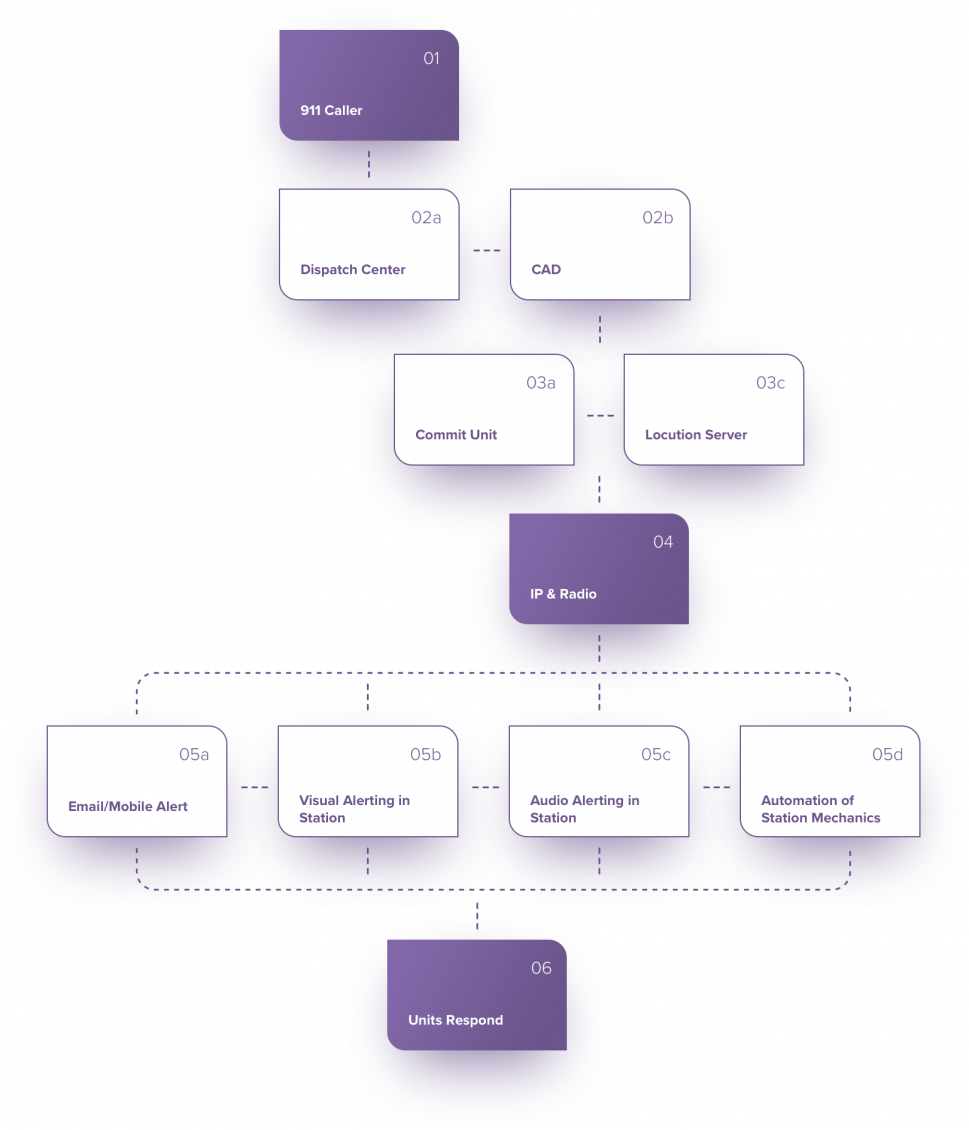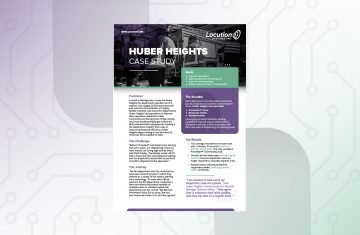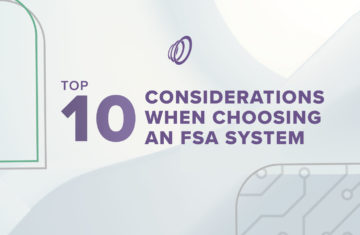What Are Fire Station Alerting Systems? The Definitive Guide.

Changes to the Public Safety Field
Lately, first responders and their institutions experience an increasing number of calls due to expanding scopes of practice, larger populations, and fewer resources. Due to growth in both the scope and demand of work, new fire station alerting (FSA) tools were developed to support modern-day first responders. The new technology has boundless potential for mission-critical workflows, including education, alerting, protection, and improving quality of life. Here is what you need to know if you are considering adopting a FSA system for your dispatch centers, stations, or both.

A Quick History of Fire Station Alerting
For years, comm centers and fire stations have leveraged radio-based alerting systems to relay mission-critical information to the appropriate units and respond as quickly as possible. As these systems were widely adopted, areas to improve became evident. Many issues arose including the inability to alert multiple units/stations simultaneously, putting distressed callers on hold while dispatchers alerted first responders, no interface with existing CAD software, misunderstood dispatches, and more, which bogged down a time-critical workflow.
Radio-based alerting systems do have their benefits and can be the right choice for some departments. They are still widely used and are often a great option for smaller departments or as a backup for any newly installed system because the redundancy complies with NFPA guidelines. However, there are now alternative, innovative solutions that exist in the modern-day Fire Station Alerting (FSA) market that address the previously stated issues and more.
Due to inflating populations, expanding scopes of practice, an increase in call frequency, diversified station capabilities, and stricter regulations, the need for a new system was apparent. Locution Systems was one of the first organizations to address these issues when we designed our off-the-shelf Fire Station Alerting (FSA) systems for the Las Vegas Fire Department. Fast forward 20 years and today’s technology has nearly eliminated call stacking in dispatch centers. Additionally, it has significantly reduced first responders’ response times by clearly and accurately automating dispatches, using visual and audio alerting through a variety of tones and lights, and automating critical station functions like bay doors and street lights. Modern FSA systems can even integrate with mobile devices to accommodate volunteer and on-call station types.
Retrofittable or built into new stations, Fire Station Alerting (FSA) systems are more advanced than ever and can help eliminate inefficiencies in your alerting and turnout process.

Increasing Demand for Automated FSA Systems
The public safety sector is often forced to navigate very tight budgets as they are not for profit institutions. This challenge is amplified with requests to “do more with less” echoing in the ears of fire chiefs and comm center managers across the country. Not only are FSA systems capable of positively impacting staff efficiency, reducing turnout times, and improving first responder health, but also they are great tools to help reduce overhead by providing efficiencies that require fewer financial resources over time by maximizing the ones you are already using.
The demand for these types of systems has grown significantly as a result of their unique value propositions and ability to scale and grow with stations and communities.
FSA Fundamentals
Although Fire Station Alerting (FSA) systems have existed since the early years of the fire service, the capabilities have SIGNIFICANTLY increased since then. Let’s take a moment to walk through the fundamentals of how these systems work and integrate into your workflow.
Fire Station Alerting (FSA) systems exist in two different geographic locations and communicate with each other to provide a holistic alerting system.
In the Dispatch Center, a system is installed that communicates with your existing CAD software – allowing a dispatcher to monitor dispatch status and commit multiple units, simultaneously. This is not a replacement for a CAD system, rather a tool to supplement its capabilities. The ability for both systems to interact with each other helps to relay information collected in the CAD system to first responders without having to put anyone on hold.
In the fire station, a cabinet is installed in the technology room to receive incoming dispatches and then alert the station to the incoming call. Depending on how a station is configured, alerts can come in the form of automated voice dispatching, strobes, rip and run printers, countdown timers, multi-unit indicator lights, and even over the radio or mobile devices if you aren’t located at the station at the time of an alert. This is also complimented with the system’s ability to automate critical station functions like opening bay doors, switching over traffic lights, and even shutting off the stove. All of these configurations are customizable to a station’s needs, and in many cases must be implemented by a station.
The capabilities in the fire station can be further customized by the addition of a zoned alerting system. Capable of alerting only relevant units to a specific call, the remaining members of the team can continue to sleep undisturbed throughout the night, which improves the overall quality of life in the station.
It’s important to note that when it comes to FSA systems, the dispatch center is kind of like the mother ship. Whatever FSA system it adopts, all associated fire stations need to use the same system if they want to adopt an FSA system for their station.
Who are FSA Systems for?
FSA systems have a viable role in any fire station or comm center. The benefits of these systems don’t discriminate whether you are a career department, a volunteer-based department, or mixed. Reducing response times is a goal every station can get behind.
With that said, not all FSA configurations make sense for every station or communication center since each location has unique needs.
Larger stations with multiple different types of units may opt to configure a zoned alerting system, while smaller stations with only a handful of responders may simply seek to leverage automated dispatching and station automation. The point to be made here is that no matter the size or scope of a specific department an optimal solution can be configured for specific wants and needs.

Common Features of FSA Systems
Although each company has its own specific specialty, (ours at Locution is our “Complete Human voice” dispatching) there are a lot of industry-standard features and benefits. The best way to dissect common features is to look at software features vs physical hardware.
Software Features
- IP Network: Nearly all FSA systems operate on an IP network, in large part due to its reliability and lightning-fast speed when sharing information between fire stations and dispatch centers.
- CAD Integration: Although nearly all FSA providers will integrate with your CAD software, the number of CAD systems an FSA solution can integrate with varies. A good way to help determine if a system works well for you is if it already integrates with your CAD system or not.
- Radio Integration: To maintain NFPA compliance, a system redundancy must be in place for any dispatch system. Many departments that utilize their existing radio network and FSA systems are capable of tapping into those to send automated dispatches over the radio. Like the CAD systems, not all FSA systems integrate with all radio systems, so it is important that your selection works with your existing system. Or a radio system can be installed by your FSA provider.
- Station Controls: Nearly all FSA providers offer some type of station control beyond simply automated dispatching over loudspeakers. Anywhere from switching traffic lights and opening bay doors, to providing printouts for first responders to take with them on a call and more.
- Automated Dispatching: Not all dispatching software is created equal. The level of understandability, types of voices used, term customization, and remote updates can all impact whether a system is right for you. The top priority being understandability and accuracy in most cases.
Hardware Features
It is important to consider FSA systems hardware requirements. Many FSA systems have a low percentage of proprietary hardware, which enables stations to go out and source their own (taking into account technical requirements from the FSA provider) equipment helping to minimize project costs. While other providers have a large percentage of proprietary hardware that forces you to buy their specific products eliminating potential cost savings.
- Cabinet: In a fire station there is physical hardware that must be installed to communicate with the server at the dispatch center and control the station. Depending on the configuration of the station your cabinet will have specific hardware.
- Visual Alerts: A critical component of any FSA system is visual alerts. The type of visual alerts that are available commonly include daytime and nighttime strobe lights, countdown timers, multi-unit indicators, LED reader boards, and rip and run printers. These systems can often be selected individually to configure the best fit for your station.
- Audio Alerts: Audio alerts are also an essential component of any alerting strategy. Often, they are the first thing you hear and are the first signal of incoming information about a call. Between ramped tones (used in zoned alerting platforms), dispatches that relay critical information to any call, and station tones, there are lots of considerations when deciding what tones and dispatching system work best for you.
Although this isn’t a comprehensive guide to all features and benefits of FSA systems, it does a good job of highlighting industry standards and what to be aware of when considering the options.
Main Benefits of an FSA System
There are a variety of benefits FSA systems can provide communication centers and fire stations that would motivate someone to consider implementing them into their workflow.
- First and foremost the primary purpose of an FSA system is to reduce the response times of first responders. That common goal is shared between dispatch centers and fire stations and for a system to help achieve that goal both entities must utilize an FSA system to recognize any improvements.
Beyond the primary objective of getting on the scene quicker, FSA systems offer a litany of additional benefits that enhance aspects of station life, health, and well-being of first responders and optimize dispatcher workflow.
- Ramped tones and alerts in fire stations help to reduce unnecessary cardiac-related stress, automating repetitive tasks helps optimize dispatcher attention, simultaneous dispatching helps to get resources on scene faster, and zoned alerting eliminates waking up unsolicited units to help responders sleep through the night, improving fatigue and burnout.
- Scalable and configurable to any station size and type, FSA systems are a great resource when considering cost-effective ways to improve existing services.
How to Choose an FSA System
Any FSA project is a big undertaking and the choices available in the market can be overwhelming, especially if you are totally new to FSA platforms. At Locution Systems we have installed hundreds of Fire Station Alerting (FSA) systems and would love to share some key considerations when going through the selection process.
- Budget: Budget is often one the largest factors when selecting any contender in a Fire Station Alerting (FSA) RFI. If you have a large budget, more options are available to you. But, if your budget is more restricted (often the case) providers with off-the-shelf components that are highly configurable ensure you aren’t paying for something you don’t need.
- Scale: Fire Station Alerting(FSA) projects range in scale from large cities with populations in the millions to small rural communities in the hundreds. Now any potential suitor that can handle large-scale projects can probably meet the needs of small departments, but it would be unwise to assume the inverse. Look and see who past clients have been and if a provider has an established track record working with cities similar to yours.
- Training: Implementing any new technology into a workflow will be disruptive, but the amount and duration of that disruption will be impacted by the amount of training on a system. Learn about the training opportunities provided by the organization to bring staff up to speed on how to best utilize the new Fire Station Alerting (FSA) system.
- Installation: FSA systems live in a world bridged between hardware and software. Both are necessary for an effective installation and depending on the scale, they can take time. Installation is a coordinated effort between the vendor, the customer, and oftentimes a third party to install all the station and comm center components. Get a clear picture of the process by sharing if the project is for a brand new station or an old station being retrofitted with a new system in your RFI.
- Maintenance & Support: No matter what system you choose, customer support, ongoing maintenance, and updates are critical to the health of your system. Many solution providers offer maintenance and support packages in addition to the system. Don’t overlook the access to customer support and ease of periodic updates when researching Fire Station Alerting (FSA) providers.
- Dispatch Voice: This may seem unexpected, but from our experience, the clarity and configurability of the voice that alerts first responders of a dispatch has been the main selling point for our systems and there is no reason it shouldn’t be for you too. If you invest all the time and money in automation and visual alerting but responders continually misunderstand audio dispatches, the project is a failure. Reducing response times should always be the main objective. It’s crucial to compare and contrast all dispatch audio to determine which sounds best to you.
Key Takeaways
The primary goal of Fire Station Alerting (FSA) systems is to rapidly reduce, response times for first responders through a coordinated effort from dispatch centers and fire stations.
Although there are many common similarities between solution providers, there are critical differences that must be researched by you and your project team to accurately define the best partner for your project. Use our research organization tool to make this process a little bit easier.
Department improvement projects are up to you and your station to define how to prioritize projects with a strict budget. Despite the cost, FSA systems have a unique value add that can maximize existing resources helping you do more with less and benefit both responders and citizens, unlike other station improvement projects.
If you have any more questions, browse our library of resources and articles that dive deeper into specific topic clusters. If Locution Systems Inc. seems like a good fit for your organization, schedule a consultation with our Solutions Specialists’ to learn how we can help rapidly, reduce your response times.



